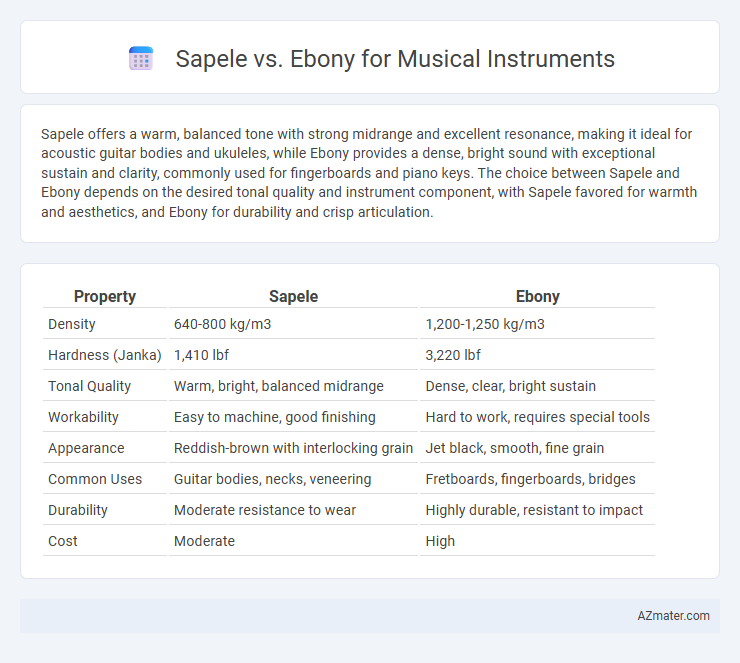Sapele offers a warm, balanced tone with strong midrange and excellent resonance, making it ideal for acoustic guitar bodies and ukuleles, while Ebony provides a dense, bright sound with exceptional sustain and clarity, commonly used for fingerboards and piano keys. The choice between Sapele and Ebony depends on the desired tonal quality and instrument component, with Sapele favored for warmth and aesthetics, and Ebony for durability and crisp articulation.
Table of Comparison
| Property | Sapele | Ebony |
|---|---|---|
| Density | 640-800 kg/m3 | 1,200-1,250 kg/m3 |
| Hardness (Janka) | 1,410 lbf | 3,220 lbf |
| Tonal Quality | Warm, bright, balanced midrange | Dense, clear, bright sustain |
| Workability | Easy to machine, good finishing | Hard to work, requires special tools |
| Appearance | Reddish-brown with interlocking grain | Jet black, smooth, fine grain |
| Common Uses | Guitar bodies, necks, veneering | Fretboards, fingerboards, bridges |
| Durability | Moderate resistance to wear | Highly durable, resistant to impact |
| Cost | Moderate | High |
Introduction to Sapele and Ebony
Sapele, a hardwood from West Africa, is prized for its durability and warm, reddish-brown hue, making it an excellent choice for musical instruments like guitars and ukuleles. Ebony, sourced primarily from species in the Diospyros genus, is renowned for its dense, jet-black wood that provides exceptional tonal clarity and a smooth playing surface, ideal for fingerboards and piano keys. Both woods offer distinct aesthetic and acoustic properties, with Sapele delivering balanced midrange tones and Ebony enhancing brightness and articulation.
Origins and Botanical Differences
Sapele (Entandrophragma cylindricum) originates from West Africa and belongs to the Meliaceae family, known for its interlocked grain and reddish-brown color, often used in guitar backs and sides for enhanced tonal brightness. Ebony, primarily Diospyros ebenum from Sri Lanka and Diospyros crassiflora from West Africa, is prized for its dense, jet-black heartwood that offers exceptional durability and a bright, clear sound in fingerboards and piano keys. The botanical distinction lies in Sapele's mahogany-like characteristics with a fibrous grain structure, whereas Ebony is a dense, fine-grained hardwood with minimal porosity, contributing to its smooth, polished finish and superior tonal clarity.
Physical Appearance and Grain Patterns
Sapele wood showcases a warm reddish-brown hue with a fine, interlocked grain offering a striking ribbon-like pattern that enhances musical instrument aesthetics. Ebony is renowned for its deep black or dark brown color with a tight, uniform grain that provides a smooth, polished surface ideal for fingerboards and accents. The contrasting grain patterns and colors of Sapele and Ebony make them distinct choices for luthiers seeking both visual appeal and functional durability in guitar construction.
Tonewood Characteristics: Sound Profiles
Sapele produces a bright, balanced tone with strong midrange presence and clear high frequencies, making it ideal for acoustic guitars and ukuleles seeking punch and clarity. Ebony offers a dense, hard surface that emphasizes sharp attack, exceptional sustain, and pronounced trebles, favored for fingerboards and piano keys due to its articulate and responsive sound. Both tonewoods provide durability, but Sapele's warmth contrasts with Ebony's crisp, focused sound profile, influencing the choice based on desired instrument timbre.
Durability and Workability
Sapele offers excellent durability with good resistance to wear, making it suitable for musical instruments that require longevity and stability. Ebony is renowned for its exceptional hardness and density, providing superior durability and a smooth, fine texture that enhances detailed craftsmanship. Both woods possess good workability, but Ebony's fine grain allows for intricate carving, while Sapele's interlocking grain can be more challenging yet still manageable for skilled luthiers.
Weight and Density Comparison
Sapele wood, with a density ranging from 640 to 700 kg/m3, offers a lighter option compared to ebony, which typically has a density of 1,000 to 1,200 kg/m3. This difference in weight affects the overall balance and resonance of musical instruments, making sapele favored for those seeking a lighter body without sacrificing durability. Ebony's higher density contributes to its superior sustain and tonal clarity, often preferred for fingerboards and parts requiring hardness and wear resistance.
Sustainability and Environmental Impact
Sapele wood, sourced primarily from West Africa, offers a more sustainable alternative to ebony due to faster growth rates and more abundant availability, reducing pressure on endangered ebony species. Ebony, known for its dense, dark appearance and superior tonal qualities, faces significant environmental challenges as overharvesting and illegal logging threaten its ecosystems and biodiversity. Choosing Sapele helps minimize deforestation and habitat destruction, supporting responsible forestry practices and ensuring long-term resource availability for musical instrument manufacturing.
Applications in Musical Instruments
Sapele wood offers a bright tone with clear midrange, making it ideal for electric guitar bodies and acoustic guitar backs and sides due to its durability and attractive grain. Ebony is prized for fingerboards and piano keys because of its dense, smooth texture, contributing to fast playability and enhanced tonal clarity. Both woods are favored in high-end instruments, with Sapele providing warmth and resonance, while Ebony ensures precision and longevity in contact areas.
Cost and Availability
Sapele offers a cost-effective alternative to Ebony, making it a popular choice for budget-conscious musicians without compromising tonal quality. Ebony is generally more expensive due to its dense, durable nature and limited availability, which drives up demand in the musical instrument market. While Ebony is prized for its smooth finish and rich sound, Sapele's wider availability supports more affordable production and faster procurement for instrument makers.
Choosing Between Sapele and Ebony
Choosing between Sapele and Ebony for musical instruments depends on tonal qualities and durability requirements. Sapele offers a warm, balanced tone with good resonance and is lighter, making it ideal for guitars and ukuleles. Ebony provides a brighter, sharper sound with exceptional hardness and wear resistance, often preferred for fingerboards and piano keys.

Infographic: Sapele vs Ebony for Musical Instrument
 azmater.com
azmater.com